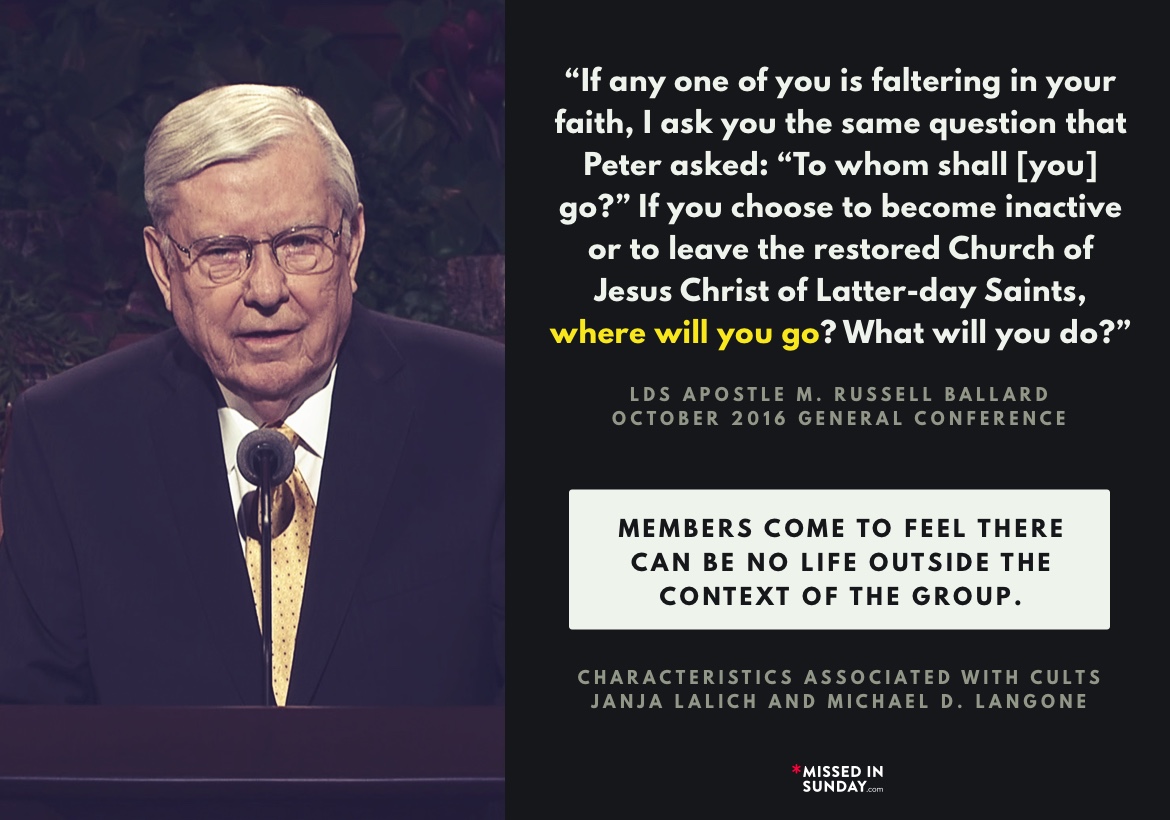Image: Melvin Russell Ballard, Jr. is an American businessman and religious leader who has been a member of the Quorum of the Twelve Apostles of The Church of Jesus Christ of Latter-day Saints since 1985.
From the October 2016 talk To Whom Shall We Go? by M. Russell Ballard
If any one of you is faltering in your faith, I ask you the same question that Peter asked: “To whom shall [you] go?” If you choose to become inactive or to leave the restored Church of Jesus Christ of Latter-day Saints, where will you go? What will you do? The decision to “walk no more” with Church members and the Lord’s chosen leaders will have a long-term impact that cannot always be seen right now. There may be some doctrine, some policy, some bit of history that puts you at odds with your faith, and you may feel that the only way to resolve that inner turmoil right now is to “walk no more” with the Saints. If you live as long as I have, you will come to know that things have a way of resolving themselves. An inspired insight or revelation may shed new light on an issue. Remember, the Restoration is not an event, but it continues to unfold.
This excerpt written by Janja Lalich and Michael D. Langone is from Take Back Your Life: Recovering from Cults and Abusive Relationships (Bay Tree Publishing, 2006). The group displays excessively zealous and unquestioning commitment to its leader, and (whether he is alive or dead) regards his belief system, ideology, and practices as the Truth, as law.
- Questioning, doubt, and dissent are discouraged or even punished.
- Mind-altering practices (such as meditation, chanting, speaking in tongues, denunciation sessions, or debilitating work routines) are used in excess and serve to suppress doubts about the group and its leader(s).
- The leadership dictates, sometimes in great detail, how members should think, act, and feel (e.g., members must get permission to date, change jobs, or marry—or leaders prescribe what to wear, where to live, whether to have children, how to discipline children, and so forth).
- The group is elitist, claiming a special, exalted status for itself, its leader(s), and its members (e.g., the leader is considered the Messiah, a special being, an avatar—or the group and/or the leader is on a special mission to save humanity).
- The group has a polarized, us-versus-them mentality, which may cause conflict with the wider society.
- The leader is not accountable to any authorities (unlike, for example, teachers, military commanders, or ministers, priests, monks, and rabbis of mainstream religious denominations).
- The group teaches or implies that its supposedly exalted ends justify whatever means it deems necessary. This may result in members participating in behaviors or activities they would have considered reprehensible or unethical before joining the group (e.g., lying to family or friends, or collecting money for bogus charities).
- The leadership induces feelings of shame and/or guilt in order to influence and control members. Often this is done through peer pressure and subtle forms of persuasion.
- Subservience to the leader or group requires members to cut ties with family and friends, and radically alter the personal goals and activities they had before joining the group.
- The group is preoccupied with bringing in new members.
- The group is preoccupied with making money.
- Members are expected to devote inordinate amounts of time to the group and group-related activities.
- Members are encouraged or required to live and/or socialize only with other group members.
- The most loyal members (the “true believers”) feel there can be no life outside the context of the group. They believe there is no other way to be, and often fear reprisals to themselves or others if they leave—or even consider leaving—the group.
Crash Course:
Warning Signs of an Unsafe Group (podcast) – Mormon Discussion
To Whom Shall We Go? – M. Russell Ballard
Characteristics Associated With Cults
Steven Hassan’s BITE model of Cult Mind Control

